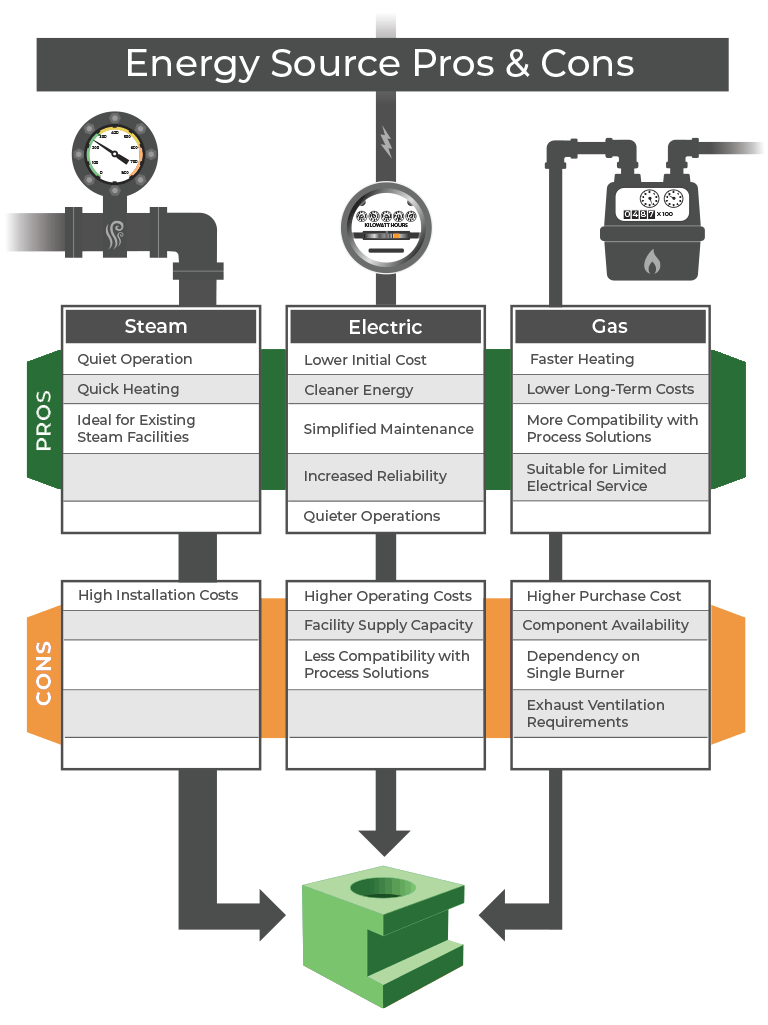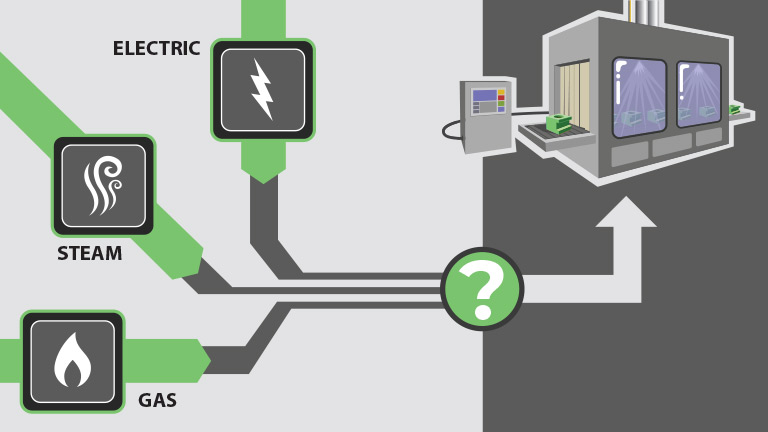Imagine a world where every industrial part, no matter how soiled, emerges pristine and perfect. This isn’t just a fantasy; it’s what happens daily in thousands of facilities worldwide, thanks to industrial parts washing machines. But have you ever stopped to consider what powers these remarkable machines? The choice of energy source is not just a technical decision; it’s also a factor that can significantly influence efficiency, cost, and environmental impact.
In this article, we dive into the world of industrial parts washing machines, focusing on the heart of their operation: the energy sources that drive them.
Whether you’re a facility manager deciding on your next big purchase, or just someone curious about how these industrial giants function, you’ll understand the pros, cons, and FAQs of the different energy sources like electric, gas, and steam.
Energy Requirements and Regulations
Before diving into the specifics of each energy type, it’s important to consider overall energy requirements and regulatory compliance for your area. Aligning your energy choice with your facility’s capabilities and environmental regulations enhances operational efficiency and supports responsible manufacturing practices.
Electric Energy

Electric energy is one of the most common and accessible forms of energy used in industrial parts washing machines. To improve the effectiveness of cleaning agents, electric heating elements are commonly incorporated into industrial washing systems. These elements heat the cleaning solution, enhancing its ability to break down and remove contaminants.
Electric energy is favored for its ease of installation, lower initial investment, and compatibility with a wide range of applications.
Electric Energy Pros:
- Lower Initial Cost: The upfront purchase cost is usually lower than that of gas systems.
- Cleaner Energy: Electric energy is generally considered more environmentally friendly.
- Simplified Maintenance: Fewer components in the heating system mean easier maintenance.
- Increased Reliability: Electric systems typically have 3-4 heating elements. This provides backup for heating ensuring continuous operation even if one element fails.
- Quieter Operations: Electric machines typically produce less noise compared to gas systems.
Electric Energy Cons:
- Higher Operating Costs: Electric energy may be more expensive to run compared to gas or steam.
- Facility Supply Capacity: Ensuring adequate electrical power for the machine can incur additional costs.
- Compatibility with Process Solutions: Heating elements must be compatible with the process solution to avoid corrosion and machine damage.
Gas Energy

Gas energy, typically using natural gas or propane, is another widely used source for industrial parts washing machines. The gas burner heats a heat exchange system through which the cleaning solution flows. This indirect heating method ensures that the solution reaches and maintains the desired temperature for optimal cleaning performance.
Gas energy is known for its cost-effectiveness and rapid heating capabilities.
Gas Pros:
- Faster Heating: Gas systems typically heat wash tanks quicker, especially for large-volume washers.
- Lower Long-term Costs: Gas is often cheaper to operate than electricity in the long run.
- Compatibility with Process Solutions: Heating elements in gas systems suit most applications, unlike electric ones.
- Suitable for Limited Electrical Service: An excellent option where electric service is constrained.
Gas Cons:
- Component Availability: Lead times for components can be long.
- Dependency on Single Burner: Gas systems typically have a single heating element. Failure of the burner system can halt operations until repairs are made.
- Higher Purchase Cost: Initial costs are usually higher than electric systems.
- Exhaust Ventilation Requirements: Proper venting through the roof is necessary, with potential for leaks or backfires.
Steam Energy

Steam energy is less commonly used in industrial parts washing machines, mainly due to the requirement of existing steam infrastructure. Steam is delivered to the cleaning chamber through a heat exchanger system. The high-temperature steam heats the cleaning solution, enhancing its ability to break down and remove contaminants.
Steam-powered washers may include filtration systems to remove particle matter and contaminants from the cleaning solution, extending its usable life. Some models may also have a condensate recovery system that collects and recycles condensed steam, contributing to cost savings and environmental sustainability.
Steam energy is an effective energy source, especially in facilities where steam is already being produced for other processes.
Steam Pros:
- Quiet Operation: Comparable to electric systems in terms of noise.
- Quick Heating: Rapid tank heating capabilities.
- Ideal for Existing Steam Facilities: Best utilized where steam infrastructure already exists.
Steam Cons:
- High Installation Costs: Adding steam capabilities to a facility that lacks them can be expensive.
Energy Sources Comparison Chart
| Electric | Gas | Steam | |
| Initial Cost | $ | $$ | $$-$$$ |
| Long-Term Cost | $$ | $ | $ |
| Energy Cost | $$ | $ | $ |
| Tank Heating Speed | Low | Medium | High |
| Burner(s)/Heating Elements (per stage) | 1-5 | 1 | 1 |
| Ventilation Requirements | No | Yes | No |
| Noise level | Low | Medium | Low |
FAQ: Energy Sources for Industrial Parts Washing Machines
What are the main differences between electric, gas, and steam energy sources for parts washing machines?
Answer: Electric energy is known for quieter operations and lower initial costs but tends to have higher operating costs. Gas energy offers faster heating and lower long-term costs but requires proper ventilation and has higher purchase costs. Steam energy is efficient in facilities with existing steam infrastructure, offering quick and uniform heating, but can be costly to install from scratch.
How do I choose the right energy source for my facility’s parts washing machine?
Answer: Consider factors like your current facility infrastructure, the size of the operations, long-term cost implications, environmental impact, and specific cleaning requirements.
Are electric parts washers more environmentally friendly than gas-powered ones?
Answer: Generally, yes. Electric parts washers typically have a smaller carbon footprint as they don’t involve burning fossil fuels directly. However, the overall environmental impact also depends on how the electricity is generated.
What are the maintenance requirements for different types of energy sources in parts washing machines?
Answer: Electric systems usually have fewer components and are easier to maintain. Gas systems require regular checks for gas leaks and ventilation issues. Steam systems need regular checks for pipe integrity and insulation efficiency.
Can I switch my parts washer from one energy source to another, like from gas to electric?
Answer: While it’s theoretically possible, it involves significant modifications and costs. It’s usually more feasible to choose the most suitable energy source at the time of purchase.
How does the initial cost compare between electric, gas, and steam parts washing machines?
Answer: Electric parts washers typically have the lowest initial cost, followed by gas, while steam systems can be the most expensive, especially if additional infrastructure is needed.
Are there any safety concerns to consider with gas and steam energy sources?
Answer: Yes. Gas systems require careful handling due to the risk of gas leaks and need proper ventilation to prevent buildup of combustible gases. Steam systems operate under high pressure and temperature, requiring regular safety checks.
How does the energy choice for a parts washer impact operational costs?
Answer: Electric washers may have higher operating costs due to electricity prices, while gas and steam can be more cost-effective in the long run but might have higher installation and maintenance costs.
Is it possible to use renewable energy sources for electric parts washing machines?
Answer: Yes, if your facility is powered by renewable energy sources like solar or wind power, your electric parts washer can effectively run on renewable energy, reducing its environmental impact.
What should I consider regarding environmental regulations when choosing an energy source?
Answer: Check local and national environmental regulations, as they can influence the feasibility and costs of operating certain types of energy sources, particularly in terms of emissions and energy efficiency standards.
Conclusion
Whether you opt for electric, gas, or steam for your industrial parts washing system, understanding each option’s pros and cons is key to making the best decision for your facility.
A quick recap:
- Electric Energy: A very common and accessible form of power. This option typically provides initial cost savings. However, be mindful of the higher operating costs that electric energy can sometimes incur.
- Gas Energy: Another popular source of energy. It’s more cost-effective over time but requires careful consideration of ventilation needs and higher upfront investment.
- Steam Energy: A specialized option for facilities with existing steam infrastructure, offering efficient and uniform heating. The significant installation cost is a primary consideration for those without existing infrastructure.

Each energy source presents a unique blend of advantages and disadvantages. The decision should align with your specific industrial requirements, budget constraints, and environmental considerations.
Ready to Choose Your Energy Source?
Unsure which energy source aligns best with your industrial needs? Our team at ALMCO is here to guide you through the decision-making process. Contact us today to discuss your options and find the perfect parts washing solution for your facility. Whether you’re ready to decide or just exploring, we’re here to provide expert advice and support every step of the way.
Looking to dive deeper?
We recommend reading the following to learn more about industrial parts washing systems:

